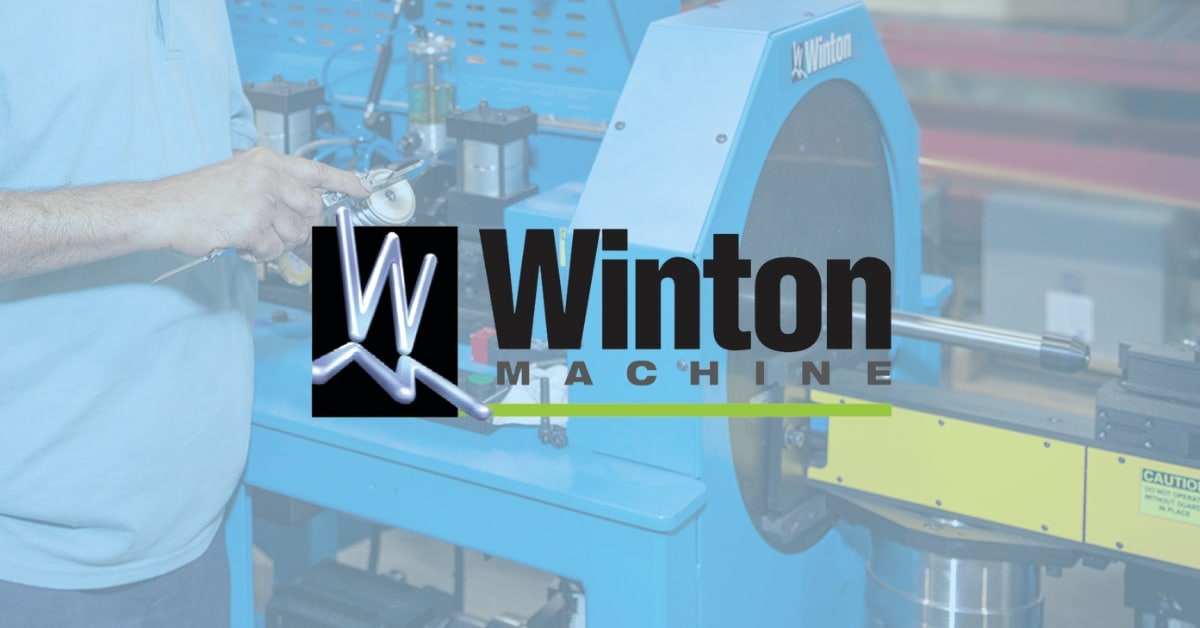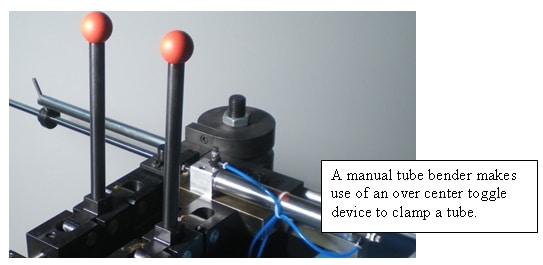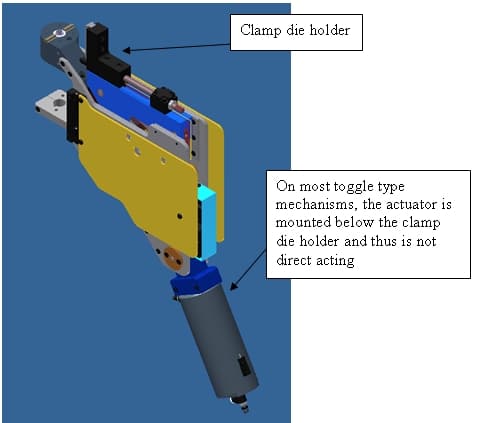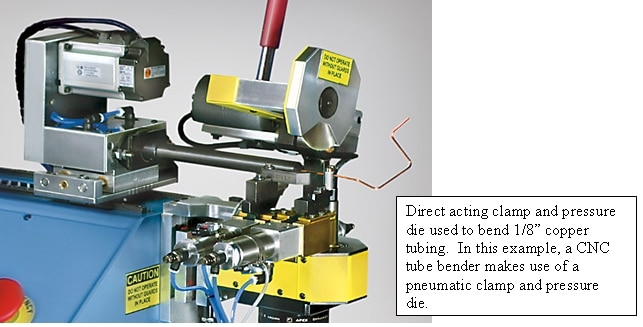Direct Acting or Toggle: Clamping on a Tube Bender is Not Always Straight Forward
Over the previous decades tube rotary draw bending machines have made use of numerous devices to hold/clamp a tube in position as the tube is being bent. For example, the job of a clamp die on a tube bending machine is to firmly clamp the tube and thus prevent it form slipping relative to the bend die as the bend die pulls the tube around itself. Another example would involve a pressure die. The primary job of a pressure die is to firmly hold the tube up against the bend die while at the same time the clamp die helps pull the tube around the bend die. Yet another example would involve a split die actuator. In this case, a split die actuator must remain firmly closed while a tube is being bent. In all cases, the clamp die, pressure die, and split die actuator all must remain rigid under loading.
In an effort to hold the tube firmly during a bending operation, machine tool builders have historically used one of two approaches; a direct acting mechanism or an over center type toggle mechanism. Both approaches have their pros and cons. Having an understanding of the difference between the two approaches can sometimes influence bend quality.
Direct Acting
An example of a direct acting clamp die would be a hydraulic cylinder pushing directly on a clamp die.
In this case the hydraulic pressure in a cylinder has a direct influence on the amount of force that the clamp die pushes on a tube. The more hydraulic pressure, the more clamping force. One of the nice advantages of this approach is that the amount of clamping force can be easily controlled by a microprocessor. This lends itself well in the case where very thin wall tubes are being bent. On the other hand, if the pressure drops off too much in the middle of a bend, then the tube may slip causing poor results.
Over Center Type Toggle Mechanism
An over center type mechanism is similar to that of a very large DE-STA-CO clamp. Used for decades, the over center approach makes use of a mechanical advantage within the mechanism itself. With a small force, an over center mechanism can lock in the closed position. This in turn can prevent a tube from moving in an unwanted direction; see below.
Because of the mechanical advantage of an over center type toggle mechanism, approach lends itself well to clamping thicker wall tubing. Moreover, an over center device can also provide the needed force to pinch a thin wall tube.
Most over center devices do have some sort of pressure adjustment via a manually adjusted screw. However, this type of adjustment does not always have the fine touch needed to bend a thin wall tube on a very tight centerline radius. This is where a direct acting clamp and/or pressure die can come into play. With the ability to control the direct acting forces in small graduations, a complex bend may become possible.
A strong advantage of an over center mechanism is that you can most often see with your eye that the mechanism itself is over center. This gives a warm feeling that the clamp die is not going to back off in the middle of a bend. With an inline system, you are reling on a power source (hydraulic, pneumatic, or electric) to maintain the inline force during a bend.
Producing the Holding Force
Weather it is a direct acting clamp die or an over center type toggle clamp die mechanism, there are three common actuators (as described above) used to create the holding forces. An actuator may be pneumatic, hydraulic, or all electric. There are pros and cons to all three approaches well beyond the space afforded to me to write this article. Nevertheless, a pneumatic powered direct acting clamp die may work well when bending Ø1/8 copper tubing. The tubing is light and 80 psi shop air will most often do the job.
However, 80 psi shop air might not apply as well when bending 1” diameter steel tubing on a 2D bend. The compressibility of the air alone can be the cause of several process problems.
In the vast majority of bending applications, an over center toggle mechanism will work well. However, in some cases, a direct acting mechanism may provide the needed gently touch needed to get the jog processed. When buying a tube bending machine, it is always a good idea to match your needs with the hardware you are about the purchase.

George Winton, P.E. designs and builds CNC tube fabrication equipment for Winton Machine in Suwanee, GA. He can be reached at gwinton@wintonmachine.com or 888.321.1499.
Related Documents
About the Machines We Build
All of our semi-rigid coax and tube fabrication machines at Winton are designed, manufactured, and tested in-house. We have a large line of standard products as well as the ability to engineer the best solution for our customer’s needs. Our experienced sales staff makes sure that our customers can justify their capital equipment investment by offering a solution that is exactly what they need in order to manufacture their parts. Please contact us today to discuss your project.





